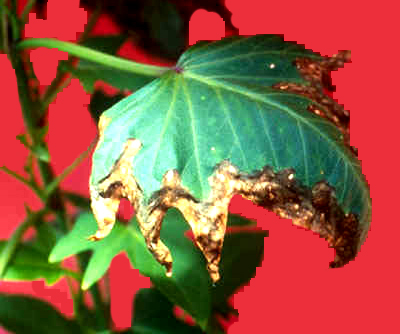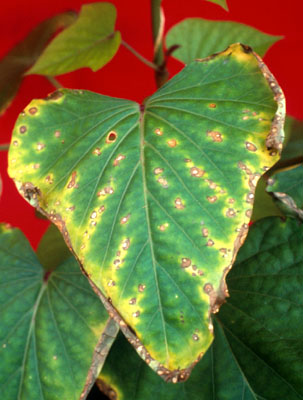|
High levels of soluble salts in the soil (usually sodium chloride or sodium sulfate)
affect the plant in a number of ways. As the saltiness of the soil solution is
increased, water becomes harder to extract and so plants become more susceptible
to drought injury. Also, excessive uptake by the plant of sodium, chloride or
sulfate may result in toxicity symptoms on the vines. In addition to the direct
effects on plant function, high sodium concentrations have detrimental effects
on soil properties, including surface crusting, increased bulk density, poor
aeration and waterlogging. Plants grown in saline-alkaline
soils may also be suffering effects of high soil pH,
including low availability of the micronutrients
iron, manganese, copper and zinc.
Salinity-alkalinity problems are
associated mainly with coastal areas, or with irrigated crops in areas of low
rainfall and high evaporation. In this case, salts may accumulate in the root
zone either from the irrigation water or from raising a saline water table.
The separate effects of toxic
concentrations of sodium, chloride and sulfate have not been studied in
sweetpotato. The following symptoms were observed in solution culture studies,
in which sodium chloride (NaCl) concentrations of 25, 50, 100 or 200 µM were
applied (equivalent to electrical conductivities in solution of 2.9, 5.6, 10.7
or 20.4 dS/m respectively). Plants suffered severe growth reductions at
concentrations in the root zone of 50-100 µM; 200 µM NaCl resulted in death of
the roots, shedding of leaves and eventually death of the whole plant.
Typical symptoms are dark necrotic
lesions on the older leaves, followed by rapid senescence and leaf drop.
Discrete chlorotic or water-soaked interveinal zones may appear before necrotic
symptoms in some cultivars. They are centred between the main veins and may be
separate, irregularly shaped zones of approximately 3-10 mm diameter,
or a continuous strip from near the midrib to the margin. Necrosis first appears
on oldest leaves at the leaf margins or the tips of lobes, from where it spreads
into interveinal tissue. As the symptoms spread to younger leaves,
however, necrosis may arise more commonly as discrete, well separated lesions
away from the margin, in the chlorotic zones if they are present, and
concentrated midway between main veins. These soon become linked with
the margin by a spreading necrosis which surrounds the original spots. The
tissue at the centre of the original lesions is generally paler than the
necrosis which subsequently spreads between them. The secondary necrotic tissue
is typically a dark steel-grey. Leaf senescence proceeds with the spread of
yellow chlorosis from the edge of necrotic zones, and leaves become dry and
shrivelled before they are shed. Leaves of axillary shoots, being younger, are
less severely affected.
In severe cases in which the roots are
extensively damaged, the plant becomes slightly wilted and generally pale, and
older leaves may be shed before the development of extensive necrosis.
Necrosis of stem tissue may lead to the death of the shoot tip.
Salinity appears to have a greater effect
on the development of storage roots than on the vines. At levels of salt which
have little or no effect on top growth, root yield may be considerably reduced.
Sodium-affected storage roots are reported to be smaller and thinner than those
of healthy plants, but NaCl did not reduce the number of storage roots per
plant.
Boron toxicity also produces necrotic
lesions on older leaves. Necrotic lesions resulting from B toxicity usually
remain discrete, or expand and fuse, while secondary necrosis does not spread
until after the leaf has turned yellow, at an advanced stage of senescence.
Lesions resulting from salinity are usually rapidly engulfed by a dark grey
secondary necrosis, which spreads from the margin into interveinal tissue
without being preceded by yellowing.
Electrical conductivity of the soil
saturation extract (ECe ) is the most commonly quoted measure of soil
salinity. Crop species vary widely in their salt tolerance, with an ECe of
4 dS/m corresponding to 50% yield reduction in sensitive crops, and over 10 dS/m
for highly tolerant crops. Sweetpotato is regarded as moderately tolerant of
salinity, suffering a 50% yield reduction at approximately 6 mS cm-1. The
threshold for response of sweetpotato to salinity is approximately 2.5 dS/m.
Soil measurements of both exchangeable
sodium, and exchangeable sodium percentage (ESP = 100 x Exchangeable Na/Cation
Exchange Capacity) are used to assess soil sodicity. While a number of factors
affect the amount of sodium required to cause dispersion (breakdown of soil
structure) in a particular soil, as a rough guide soils with exchangeable sodium
greater than 1 cmol(+)/kg soil, or an ESP ³15 may be regarded as potentially
sodic. In such soils, sweetpotato crops may suffer from both sodium toxicity,
and the deterioration of soil permeability and aeration caused by high sodium.
In the case of sodium chloride salinity,
the chloride concentration in the leaf tissue appears to correlate more closely
with growth response, and to be less variable among cultivars, than sodium
concentrations. This suggests that chlorine is the more toxic element to
sweetpotato, so the response obtained is that of chlorine toxicity. A critical
concentration for chlorine toxicity of 1.5% (15,000 mg Cl/kg) was determined in
7th to 9th youngest leaf blades in solution culture experiments. In a soil-based
experiment, a lower critical concentration, of approximately 0.9%, appeared to
apply. This may be due to the effect of salinity on plant water uptake, which
became limiting in the soil-based culture.
Cultural control
Appropriate measures to overcome the
detrimental effect of salt accumulation depend on a proper understanding of the
problems present at the site. Improved drainage and more efficient water
delivery systems (minimising the volume of water required to maintain the crop)
may slow salination of irrigated land so that seasonal rains may leach
sufficient salt to maintain fertility. The application of gypsum may reduce the
deleterious effects of sodium on soil structure.
The most practical solution in many
instances may be to select salt-tolerant cultivars for use on affected areas.
CIP researchers have had some success in selecting cultivars tolerant of
salinity in coastal Peru and Bangladesh.
Bernstein, L 1964. Salt tolerance of plants. Agricultural Information Bulletin 283, USDA,
Washington DC.
Chávez, R., Mendoza, H. and Espinoza, J. 1995. Breeding
sweetpotato for adaptation to arid and saline soils. CIP Circular, August 1995,
pp 2-7.
Greig, J.K. and Smith, F.W. 1961. Sweetpotato growth, cation
accumulation and carotene content as affected by cation level in the growth
medium. Proceedings of the American Society for Horticultural Science 77,
463-472.
International Potato Center 1995. Program Report: 1993-1994.
CIP, Lima, Peru. p 50.
Landon, R.J. 1991) (ed.) Booker tropical soil manual: a
handbook for soil survey and agricultural land evaluation in the tropics and
subtropics. Booker Tate Ltd; Longman, London.
OSullivan, J.N., Asher, C.J. and Blamey, F.P.C. 1997.
Nutrient Disorders of Sweet Potato. ACIAR Monograph No. 48, Australian Centre
for International Agricultural Research, Canberra, 136 p.
Contributed by:
Jane O'Sullivan
|
Characteristics
and occurrence
Symptoms
Confusion
with other symptoms
Diagnostic
tests
Management
References

Severe growth reduction and leaf damage at high NaCl
resulting from increasing salt (NaCl) concentrations in the root zone (J.
O'Sullivan).

Chlorosis between veins on a mature leaf
(J.
O'Sullivan).

Necrosis spreading from the margins to
areas between the main veins (J. O'Sullivan).

Necrotic spots aligned midway between the main
veins (J. O'Sullivan).

Interveinal lesions are engulfed by spreading
necrosis. Necrosis is often extensive before yellowing begins (J.
O'Sullivan).

Severe root damage causing shedding of oldest
leaves (J. O'Sullivan). |

